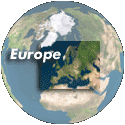
Place de l'Eglise, 10 years after ...
Houdan, Yvelines, France
12h00 (gmt+1) december 22
© 2007 Denis Gliksman, All Rights Reserved.
The first "wrinkle event" was very restrictive about the shooting time, the solstice, and the weather 10 years ago was so horrible I decided at that time to keep things simple, just bringing a simple street view of a small village.
The idea was also "to be there and to support the event", the interest being also in the global contribution, with others' views. In the title was the idea "A collaborative synchronized effort by QTVR producers around the globe." We aren't doing anything else with the WWP now ....
There was also 10 years ago a need to resist against a company that was trying to intimidate photographers, developers and companies in using some panorama technologies, and the Wrinkle in Time event was courageous enough to show the logo of this fight, it has to be said here. (See bottom of old Wrinkle home page)
Another interesting point is the technological evolution: 10 years ago I needed to use a trick to be able to show the top of the church due to vertical field of view limitation at that time, no spherical view was possible in QuickTime Player: I had to have 2 movies (both linked together), one being bent to the top! ...
Here we need to thanks all those worked hard to bring us all these new tools, the first being Pr. Helmut Dersch with Panorama Tools.
I was to forget that 10 years ago wished everybody a "Joyeux Noel", same now!
http://www.hotspotshawaii.com/wrinkle.html http://hotspotshawaii.com/mac5alias/wrinkles/wrinkle16.html
In 1997 i shot digital with a Nikon-Fuji E2, with a 20-35 mm zoom. Hfov was about 58°. I needed 12 images to make a 360*70° cylindrical panorama. Image were 1280*1000 pixels, jpegs only, weighting an average of 350 ko. All the sources for a pano weighted less than 5 Mo. Cards for the camera where 16-32 Mo ... Considering internet bandwidth at that time building a 200-300 ko panorama was a correct choice.
In 2007 I shot with a Nikon D2X, a 10,5 mm fisheye. Hfov is about 86°. The full spherical 360*180° panorama can be done with only 10 images. The files are 4288*2848 pixels, raw 12 bits. I store raw and jpeg for each view, it weights more than 15 Mo/image ... I shot 3 stops for each image, using in-camera bracketing. I have 3 cards of 4 gigas and 1 of 2 gigas. There are more than 600 Mo of source images for a single pano. I then converted the 45 nef files to tiff with Capture NX to take off the chromatic aberations.
Stitching was done PTgui Pro, (using the HDR option for fun). No control points adjustment was needed, i did a 12000*6000 full spherical panorama, multi-layered psd file, with 3 density of the panorama, plus the HDR tonemapped layer.
Post-production was done in Photoshop CS2. No stiching retouching was needed, just a few ghost removed of moving objects, and some cigarettes (...) cleaned on the ground. I fine-tuned colors with some color layers added.
The nadir logo was done in Photoshop CS2 using Kekus Panotools Plugin for Mac OsX.
The 2 sizes of movies, fullscreen and small version, were done in CubicConverter, from a file using less than a quarter of the resolution of the master . 600 ko, (the double of 10 years ago big version) is actually considered correct for a light version, and more than 2 megs for a fullcreen movie doesn't surprise anybody ...
With this high quality approach, the overall project weights 3,1 gigas, for a single panorama. And it needed 5 different softwares to be completed. Stitching a 740 Mo HDR multilayered (4) .psd took hours, even with the fast computers we have now...
I could have choosen a faster/lighter way, with just 4 images done with a 8 mm fisheye and directly from one density of the jpeg sources. Quality wouldn't have been the same, but it could have been much faster ...


 Tap or click the zoom icon in the bottom right corner of the picture to switch between in-page and fullscreen view
Tap or click the zoom icon in the bottom right corner of the picture to switch between in-page and fullscreen view